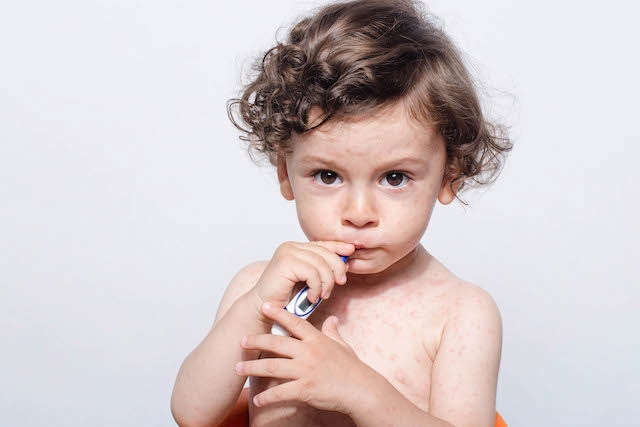Roseola is a contagious disease that mainly affects babies and children from the ages of 3 months to 2 years. Also referred to as roseola infantum, it is associated with symptoms such as sudden high-grade fever, which can go up to 104.0ºF (40ºC), decreased appetite, irritability and the emergence of a pink rash. This rash presents as small pink patches on the child's skin, especially on the torso, neck, and arms, that may or may not be itchy.
There are many types of viruses that can cause roseola, like human herpes virus types 6 and 7, echovirus 16, adenovirus, among others, which are transmitted through droplets of saliva. Although infection with the same virus doesn’t happen more than once, it is possible to get roseola more than once if the child is infected with a different virus each time.
Despite causing uncomfortable symptoms, roseola is usually benign and resolves on its own without any complications. However, the pediatrician can prescribe a treatment to relieve the child's symptoms, such as antihistamine ointments to help with itching or paracetamol to control fever.

Main symptoms
The main symptoms of roseola include:
- High fever, between 38 and 40ºC (or 100.4 and 104ºF), which lasts 3 to 4 days
- Pink rash on the skin, which may or may not itch
- Decreased appetite
- Swollen lymph nodes
- Eyelid swelling
- Irritability
- Cough
- Runny nose
- Throat redness
- Diarrhea
Roseola symptoms can last around 7 days. The rash can appear on the trunk, neck and arms and can last between 2 to 5 days.
Also recommended: Baby Fever: What It Is, Common Causes & How to Treat tuasaude.com/en/baby-feverConfirming a diagnosis
To confirm a roseola diagnosis, a pediatrician will evaluate the child's symptoms and, if necessary, request testsingthat can confirm the disease. Testing is often ordered as many health conditions can cause fever and a red rash on the child's body.
How it spreads
Roseola is transmitted through contact with the saliva of another contaminated child. It can spread with speaking, kissing, coughing, sneezing, or playing with contaminated toys. Children can be contagious even before skin patches appear. Symptoms usually appear after 5 to 15 days of the initial exposure.
This infection is usually not transmitted to adults because most individuals have sufficient immunity against roseola, even if they have never had the disease. It is possible, however, for an adult to contract roseola if their immune system is weakened. It is also rare for a pregnant woman to become infected with the roseola virus and develop the disease during pregnancy, however, even if she does become infected, there are no health risks for the fetus.
Treatment options
Roseola is benign and usually resolves on its own. The treatment typically consists of managing the presenting symptoms, like using acetaminophen to reduce fever and decrease the risk of febrile seizures. Learn more about what can cause fever in children and how to treat it.
In addition to drugs, there are other measures that can help control fever, such as:
- Dressing the child in light clothing;
- Avoiding quilts and blankets, even if is winter;
- Bathing the child in slightly warm water;
- Placing a cloth soaked in cold water on the child's forehead and also under the armpits for a few minutes.
By following these guidelines, the fever should go down a little without having to resort to medication, but the child should be checked for fever several times a day. Day care and contact with other children while sick should be avoided.
Another way to help treatment and reduce fever is ash tree tea, as it has antipyretic properties.
